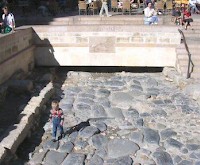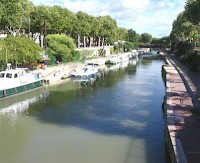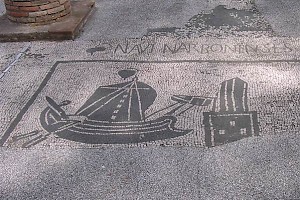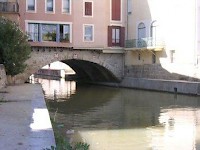Narbo Martius (Narbonne)
Q11938382Narbo Martius: important Roman city in Roman France, capital of Gallia Narbonensis, modern Narbonne.
Origin

According to Velleius Paterculus, Narbo Martius was founded in 118 BCE as a Roman colonia in land of the Volcae Arecomisci,note who lived here on a hillfort that is now named Montlaurès but used to be called Naro.note The new city was part of the general project to develop this area: the Via Domitia, which connected Italy to Hispania. Another road led to Toulouse and Bordeaux.
Narbo used to command a crossing in the Arax (Aude), which emptied itself in a lagoon that was connected to the Mediterranean Sea. Later, the river changed its course, and the original stream dried up; in 1686, the French king Louis XIV ordered the dredging of the old river, which is now known as the Canale de la Robine but might as well be called Arax or Old Aude.
Republican City

The Roman town soon became the capital of a new province.
Narbo is spoken of as the naval-station of the Arecomisci alone, though it would be fairer to add "and of the rest of Celtica" - so greatly has it surpassed the others in the number of people who use it as a trade center. [...] They are no longer barbarians, but are, for the most part, transformed to the type of the Romans, both in their speech and in their modes of living, and some of them in their civic life as well.note
When Strabo wrote these words, Julius Caesar had already refounded the city. The reason for this was that the most powerful city in southern France, Massilia, had resisted Caesar during the civil wars; the dictator now wanted to break its power and therefore resettled Narbo with veterans of the Tenth Legion. The full name of the city was now Colonia Julia Paterna Decumanorum, "the ancestral Julian colony of the soldiers of the Tenth". The underground warehouse and the House of the Genius date back to this age.
Empire

The emperor Augustus used Narbo as the capital of not just Gallia Narbonensis, but the three other Gallic provinces as well.note The Historia Augusta mentions a great fire in Narbo, implying that the emperor Antoninus Pius offered help to restore the city.note
Narbonne was an important trade center. A mosaic in Ostia proves the existence of a group of sailors who were specialized in the trade between Narbo and the port of Rome.

Among the main products were ore from the Montaigne Noire, ceramics, wine, salt, and corn. Many inscriptions mention negotiatores or the members of the traders' collegia. Archaeologists have found traces of warehouses on many places, but also remains of the Forum, Capitolium, amphitheater, temples, a bathhouse. A theater is mentioned by Sidonius Apollinaris,note and there was an altar for the worship of the emperor. And of course, the governor had his palace in Narbo Martius.
In the third century, the first Christians are attested. Their basilica and necropolis have been identified at Le Clos de la Lombarde. This was a crisis age, and the city was now smaller than it used to be; a new wall surrounded an area of only 35 hectare. The Visigoths captured Narbo in 462.
Among the citizens of Narbo Martius were the sophist Favorinus and the emperor Carus (282-283).